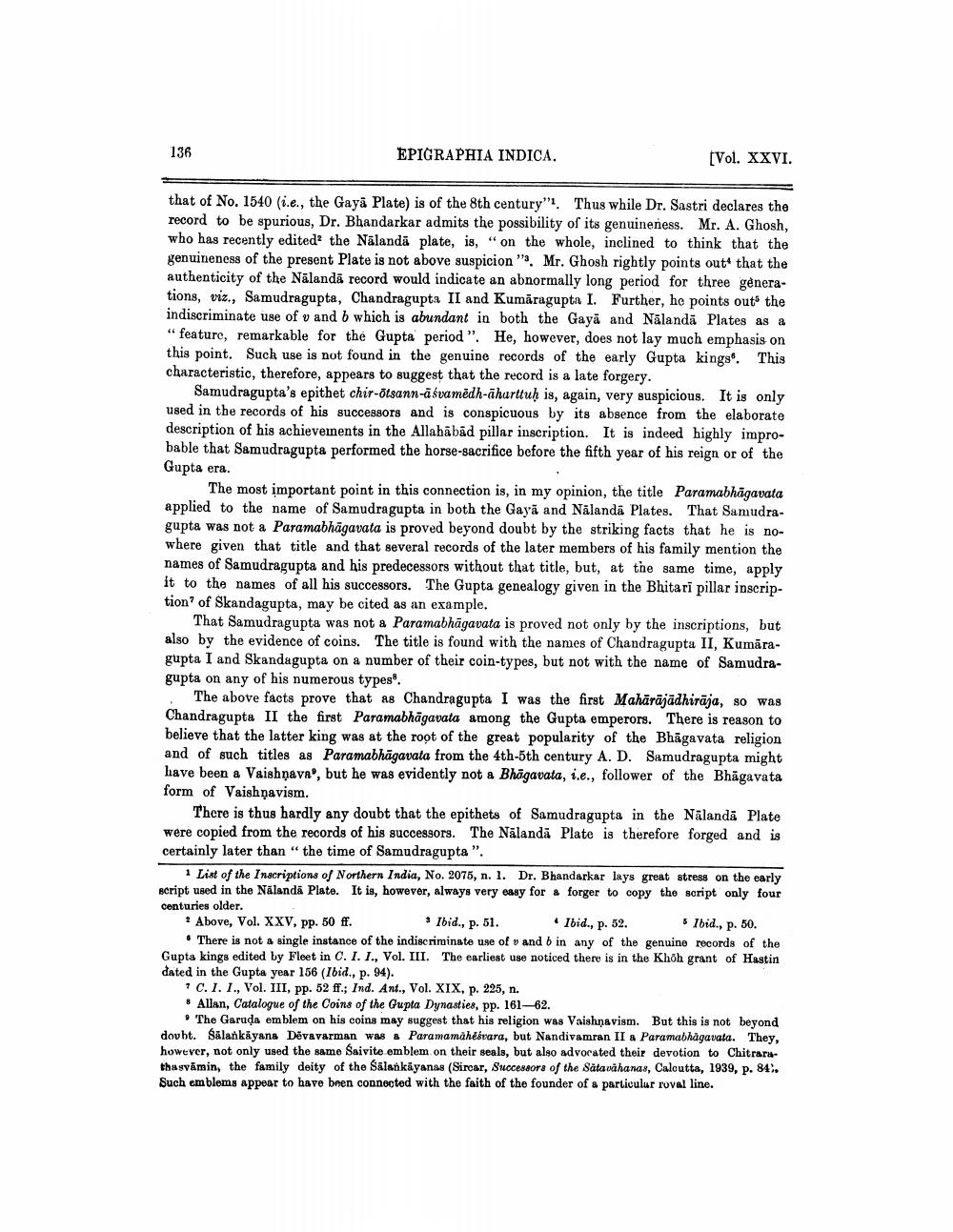________________
136
EPIGRAPHIA INDICA.
Vol. XXVI.
that of No. 1540 (i.e., the Gaya Plate) is of the 8th century"! Thus while Dr. Sastri declares the record to be spurious, Dr. Bhandarkar admits the possibility of its genuineness. Mr. A. Ghosh, who has recently edited the Nālandā plate, is," on the whole, inclined to think that the genuineness of the present Plate is not above suspicion ". Mr. Ghosh rightly points out that the authenticity of the Nalanda record would indicate an abnormally long period for three generations, viz., Samudragupta, Chandragupta II and Kumāragupta I. Further, he points out the indiscriminate use of v and b which is abundant in both the Gaya and Nalanda Plates as a "feature, remarkable for the Gupta period ". He, however, does not lay much emphasis on this point. Such use is not found in the genuine records of the early Gupta kings. This characteristic, therefore, appears to suggest that the record is a late forgery.
Samudragupta's epithet chir-õtsann-āśvamēdh-āhurttuḥ is, again, very suspicious. It is only used in the records of his successors and is conspicuous by its absence from the elaborate description of his achievements in the Allahābād pillar inscription. It is indeed highly improbable that Samudragupta performed the horse-sacrifice before the fifth year of his reign or of the Gupta era.
The most important point in this connection is, in my opinion, the title Paramabhāgavata applied to the name of Samudragupta in both the Gayā and Nālandā Plates. That Samudragupta was not a Paramabhāgavata is proved beyond doubt by the striking facts that he is nowhere given that title and that several records of the later members of his family mention the names of Samudragupta and his predecessors without that title, but, at the same time, apply it to the names of all his successors. The Gupta genealogy given in the Bhitari pillar inscription of Skandagupta, may be cited as an example.
That Samudragupta was not a Paramabhāgavata is proved not only by the inscriptions, but also by the evidence of coins. The title is found with the names of Chandragupta II, Kumāragupta I and Skandagupta on a number of their coin-types, but not with the name of Samudragupta on any of his numerous types. • The above facts prove that as Chandragupta I was the first Mahārājādhirāja, so was Chandragupta II the first Paramabhāgavata among the Gupta emperors. There is reason to believe that the latter king was at the root of the great popularity of the Bhāgavata religion and of such titles as Paramabhāgavata from the 4th-5th century A. D. Samudragupta might have been a Vaishnava', but he was evidently not a Bhagavata, i.e., follower of the Bhagavata form of Vaishộavism.
There is thus hardly any doubt that the epithets of Samudragupta in the Nalanda Plato were copied from the records of his successors. The Nālanda Plate is therefore forged and is certainly later than the time of Samudragupta".
1 List of the Inscriptions of Northern India, No. 2075, n. 1. Dr. Bhandarkar lays great stress on the early script used in the Nalanda Plate. It is, however, always very easy for a forger to copy the script only four centuries older. * Above, Vol. XXV, pp. 50 ff. Ibid., p. 51. Ibid., p. 52.
Ibid., p. 50. • There is not a single instance of the indiscriminate use of vand 6 in any of the genuine records of the Gupta kings edited by Fleet in C. I. I., Vol. III. The earliest use noticed there is in the Khoh grant of Hastin dated in the Gupta year 156 (Ibid., p. 94).
C. I. I., Vol. III, pp. 52 ff.; Ind. Ant., Vol. XIX, p. 225, n. • Allan, Catalogue of the Coins of the Gupta Dynasties, pp. 161-62.
The Garuda emblem on his coins may suggest that his religion was Vaishnavism. But this is not beyond dovht. Sälankāyana Dévavarman was & Paramamahekara, but Nandivamran II a Paramabhagavata. They, however, not only used the same Saivite emblem on their seals, but also advorated their devotion to Chitrari thasvimin, the family deity of the Sulankiyanas (Sircar, Successors of the Satavahanas, Caloutta, 1939, p. 84). Such emblems appear to have been connected with the faith of the founder of a particular roval line.




